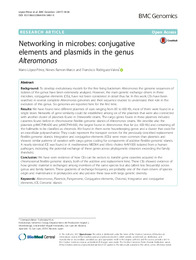Por favor, use este identificador para citar o enlazar este ítem:
https://hdl.handle.net/11000/4842
Networking in microbes: conjugative
elements and plasmids in the genus
Alteromonas
Título :
Networking in microbes: conjugative
elements and plasmids in the genus
Alteromonas |
Autor :
López Pérez, Mario
Ramon Marco, Nieves
Rodríguez Valera, Francisco |
Departamento:
Departamentos de la UMH::Producción Vegetal y Microbiología |
Fecha de publicación:
2016-12-22 |
URI :
http://hdl.handle.net/11000/4842 |
Resumen :
Background: To develop evolutionary models for the free living bacterium Alteromonas the genome sequences of
isolates of the genus have been extensively analyzed. However, the main genetic exchange drivers in these
microbes, conjugative elements (CEs), have not been considered in detail thus far. In this work, CEs have been
searched in several complete Alteromonas genomes and their sequence studied to understand their role in the
evolution of this genus. Six genomes are reported here for the first time.
Results: We have found nine different plasmids of sizes ranging from 85 to 600 Kb, most of them were found in a
single strain. Networks of gene similarity could be established among six of the plasmids that were also connected
with another cluster of plasmids found in Shewanella strains. The cargo genes found in these plasmids included
cassettes found before in chromosome flexible genomic islands of Alteromonas strains. We describe also the
plasmids pAMCP48-600 and pAMCP49-600, the largest found in Alteromonas thus far (ca. 600 Kb) and containing all
the hallmarks to be classified as chromids. We found in them some housekeeping genes and a cluster that code for
an exocellular polysaccharide. They could represent the transport vectors for the previously described replacement
flexible genomic islands. Integrative and conjugative elements (ICEs) were more common than plasmids and
showed similar patterns of variation with cargo genes coding for components of additive flexible genomic islands.
A nearly identical ICE was found in A. mediterranea MED64 and Vibrio cholera AHV1003 isolated from a human
pathogen, indicating the potential exchange of these genes across phylogenetic distances exceeding the family
threshold.
Conclusion: We have seen evidence of how CEs can be vectors to transfer gene cassettes acquired in the
chromosomal flexible genomic islands, both of the additive and replacement kind. These CEs showed evidence of
how genetic material is exchanged among members of the same species but also (albeit less frequently) across
genus and family barriers. These gradients of exchange frequency are probably one of the main drivers of species
origin and maintenance in prokaryotes and also provide these taxa with large genetic diversity.
|
Palabras clave/Materias:
Alteromonas
Plasmids
Pangenome
Conjugative elements
Chromid
Integrative and conjugative
elements
ICE
Genomic islands |
Área de conocimiento :
Microbiología |
Tipo de documento :
info:eu-repo/semantics/article |
Derechos de acceso:
info:eu-repo/semantics/openAccess |
DOI :
https://doi.org/10.1186/s12864-016-3461-0 |
Aparece en las colecciones:
Artículos - Producción vegetal y microbiología
|
 La licencia se describe como: Atribución-NonComercial-NoDerivada 4.0 Internacional.
La licencia se describe como: Atribución-NonComercial-NoDerivada 4.0 Internacional.

 La licencia se describe como: Atribución-NonComercial-NoDerivada 4.0 Internacional.
La licencia se describe como: Atribución-NonComercial-NoDerivada 4.0 Internacional.
.png)